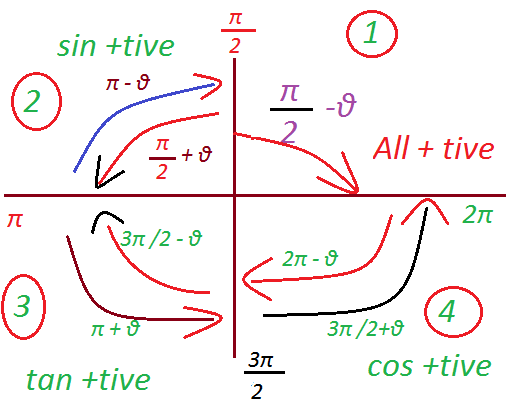Quadrant Laws of trigonometric ratio: (1) If theta (θ) is added to or subtracted from odd multiple of right angle means (π /2 angle) the trigonometric ratio change into co- ratio and vice versa.

For example
Sin (π /2-θ)= cos θ and cos(3 π /2+ θ) = Sin θ
(2) If θ added to or subtracted from an even multiple of π /2, the Trigonometric ratio shall remain the same.
(3) So far as the sign of the results is concerned, it is determined by the quadrant in which the terminal arm of the angle lies.
For example:
Sin (π – θ)= cos θ, tan(π + θ) = tan θ, cos(2 π – θ) = cos θ
Odd multiple of π / 2 in sin angle
Sin (π /2-θ), Sin (π /2+θ), Sin (3π /2-θ) and Sin (3π /2+θ) are odd multiple of π / 2 are involved.
Therefore
sin will change into cos
Terminal side in quadrant 1 (π /2-θ)
Sin (π /2-θ) = cos θ
Terminal side in quadrant 2 (π /2+θ)
Sin (π /2+θ) = cos θ
Terminal side in quadrant 3 (3π /2 – θ)
Sin (π /2- θ) = – cos θ
Terminal side in quadrant 3 (3π /2 + θ)
Sin (3π /2+ θ) = – cos θ
Even multiple of π / 2 in cos angle
cos (π -θ), cos (π+θ), cos (2π -θ) and cos (2π +θ)
cos will remain cos
Quadrant wise
Terminal side in quadrant 2: (π -θ)
cos (π -θ) = – cos θ
Terminal side in quadrant 3 🙁π+θ)
cos (π +θ) = – cos θ
Terminal side in quadrant 4: (2π – θ)
cos (2π -θ) = cos θ
Terminal side in quadrant 1: (2π+θ)
cos (2π +θ) = cos θ
RELATED POST:
Trigonometric Function of any Angle
